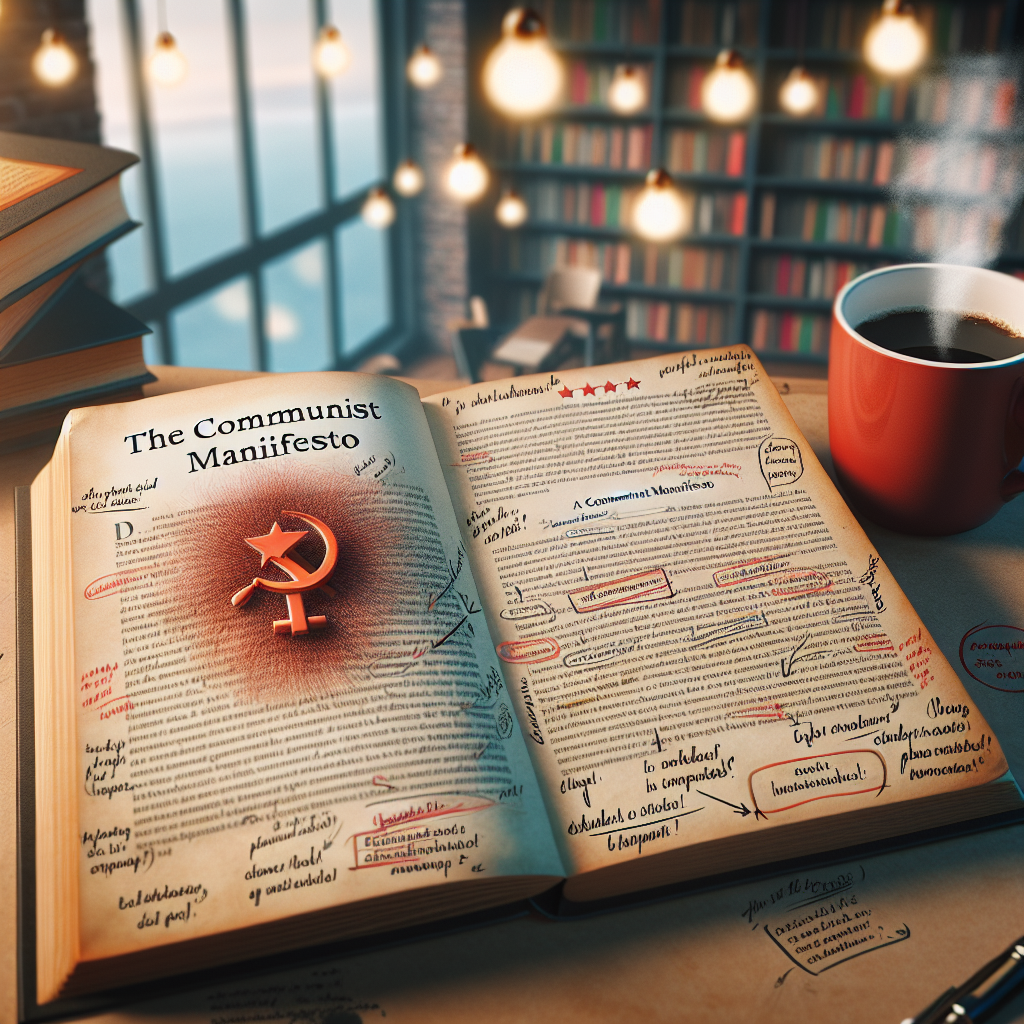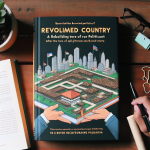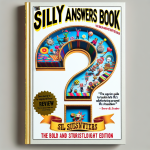As an Amazon Associate I earn from qualifying purchases.
The Revolutionary Blueprint: Understanding The Communist Manifesto's Enduring Impact
Few texts have reshaped our understanding of society and economics as profoundly as Karl Marx and Friedrich Engels' *The Communist Manifesto*. This seminal work, first published in 1848, serves as a clarion call for the proletariat, compelling them to rise against the oppressive structures of bourgeois capitalism. Its unrelenting critique of the disparities brought about by the capitalist system resonates strongly even in today’s globalized world. As we delve into this book review, it becomes imperative to unravel the enduring impact and relevance this manifesto holds in contemporary discourse.
*The Communist Manifesto* not only lays bare the exploitation inherent in capitalist societies, but it also offers a revolutionary framework for addressing social inequality and workers’ rights. The text elucidates the fundamental conflict between the working class and the ruling class, providing a clear analysis of the socioeconomic conditions that perpetuate class struggles. By advocating for the abolition of bourgeois property and the establishment of a classless society, *The Communist Manifesto* proposes radical solutions to entrenched economic problems. Its call for collective ownership of the means of production endeavors to dissolve the systemic inequities that have plagued human societies for centuries.
Plot
The plot of “The Communist Manifesto” centers on the historical and societal analysis of capitalism and the call for revolutionary change by the working class. It provides a critique of the capitalist system, explaining how it leads to the exploitation and alienation of the proletariat, or working class. The narrative progresses through the identification of class struggles, the rise of the bourgeoisie, and the subsequent socialist revolution proposed as a solution to the social and economic inequalities perpetuated by capitalism. The text concludes with an urgent call to action, rallying the working class across the globe to unite and overthrow the capitalist systems that oppress them.
Characters
As a political manifesto rather than a fictional story, “The Communist Manifesto” does not feature characters in the traditional literary sense. Instead, it personifies social classes as the primary “characters.” The bourgeoisie, or capitalist class, is depicted as the oppressor, owning the means of production and exploiting the proletariat. The proletariat, representing the working class, are portrayed as the oppressed, suffering under the weight of capitalist exploitation. The Manifesto calls for the proletariat to rise up against the bourgeoisie to create a classless society. Additionally, historical figures such as Karl Marx and Friedrich Engels, the authors themselves, play a significant implicit role as the architects of the Manifesto’s ideas.
Writing Style
“The Communist Manifesto” is written in a compelling, direct, and urgent tone that seeks to engage and mobilize its readers. The authors use a combination of rhetorical strategies, including declarative statements, vivid imagery, and persuasive appeals, to advance their arguments. The text is structured with clarity and purpose, featuring well-organized sections that build progressively towards the revolutionary call to action. Marx and Engels employ powerful, unequivocal language, punctuated by memorable phrases and slogans such as “Workers of the world, unite!” The Manifesto is both analytical and argumentative, providing a detailed critique of existing societal conditions while offering a visionary alternative through socialism.
Setting
The setting of “The Communist Manifesto” spans the socio-economic landscape of the mid-19th century, during the early stages of industrial capitalism in Europe. The text addresses the conditions prevalent in various European countries, especially those undergoing rapid industrialization, such as England, France, and Germany. The harsh realities of factory life, urban squalor, and the stark contrast between the affluent bourgeoisie and impoverished proletariat create a backdrop for the narrative. While it is rooted in the historical context of its time, the Manifesto also reaches beyond its immediate setting to envision a universal struggle, addressing workers across different nations and calling for a global proletarian movement.
Unique aspects
One of the unique aspects of “The Communist Manifesto” is its enduring influence on political thought and revolutionary movements worldwide. Its radical vision of a classless, stateless society and its critique of capitalism have inspired countless social and political movements. Additionally, the Manifesto's prophetic analysis of capitalism's tendencies—such as market fluctuations, economic crises, and globalization—remains relevant today. The concise yet potent distillation of complex theories into an accessible document is another distinctive feature. Its combination of theoretical rigor, historical analysis, and revolutionary fervor sets it apart as not just a political pamphlet but also a seminal work of political philosophy and social critique.
Detailed Discussion on Different Aspects or Subtopics
Historical Context and Significance
The “Communist Manifesto” was published in 1848, a period marked by political upheavals and the rise of industrial capitalism. Understanding this historical context is crucial. Europe was experiencing rapid industrialization, leading to significant social stratification. The Manifesto responded to the urgent need to address the growing inequalities and the exploitation of the laboring classes. Its call for revolution was not just theoretical but a reaction to the tangible suffering and systemic injustices of the time.
Impact on Later Movements and Ideologies
The Manifesto had a profound impact on subsequent socialist and communist movements, influencing revolutions and the formation of socialist states. For example, it directly inspired the Bolshevik Revolution in Russia, which led to the establishment of the Soviet Union. Moreover, its ideas have permeated various strands of political thought, from Marxist theory to social democracies. The text's emphasis on class struggle and the call for workers' solidarity remain central themes in contemporary leftist ideologies.
Relevance to Modern Capitalism
Many of the Manifesto’s criticisms of capitalism remain pertinent today. Issues such as income inequality, labor exploitation, and economic instability continue to be significant concerns. While the specific conditions have evolved, the general principles laid out—concentration of wealth, commodification of labor, and cyclical crises—still resonate. Contemporary debates around globalization, neoliberalism, and economic justice often echo the themes articulated in the Manifesto, highlighting its enduring relevance.
Cultural and Philosophical Contributions
Beyond its political implications, “The Communist Manifesto” has contributed immensely to cultural and philosophical discourse. It challenged existing ideologies and offered an alternative way of understanding history and society through dialectical materialism. This theoretical framework has influenced not just economics and politics but also sociology, anthropology, and critical theory. Its cultural impact is evident in literature, art, and even popular culture, where themes of class struggle and revolution are recurrent.
Criticisms and Controversies
The Manifesto has not been without criticism. Some argue that its call for violent revolution is impractical and ethically problematic. Others point out the utopian nature of its vision, questioning the feasibility of a classless, stateless society. Additionally, its deterministic view of history, implying an inevitable progression towards socialism, has been challenged by subsequent historical developments. The experiences of communist regimes, often marked by authoritarianism and economic hardship, have also led to critical reassessment of the Manifesto’s prescriptions.
The Communist Manifesto Book Review: Pros and Cons Analysis
Pros of The Communist Manifesto Book Review
Clarity and Insight
The Communist Manifesto book review often provides clarity and insightful perspectives on Marx and Engels' original text. Through examining the historical context, underlying theories, and subsequent impacts of the manifesto, readers can gain a deeper understanding. This enriched comprehension can make the dense and ideologically driven content of the manifesto more accessible, thereby enhancing user experience by helping readers engage with the material more meaningfully.
Engaging Commentary
An engaging book review captures the user’s interest through thoughtful commentary and critical analysis. Reviews that juxtapose the ideas presented in The Communist Manifesto with contemporary socio-economic issues can create a stimulating intellectual discourse. This kind of content not only informs but also provokes thought and discussion, which significantly enhances the user experience by making it interactive and reflective rather than passive.
Contextual Background
Book reviews that provide extensive historical and sociopolitical background give readers the necessary context to understand The Communist Manifesto. They delve into the conditions that prompted Marx and Engels to write the manifesto, which helps modern readers appreciate its relevance. Such context is invaluable for those unfamiliar with 19th-century European political history and significantly improves the user experience by enabling a more thorough understanding.
Cons of The Communist Manifesto Book Review
Bias and Subjectivity
Book reviews can sometimes be biased or heavily subjective, reflecting the reviewer’s personal opinions rather than an objective analysis. This can skew the reader’s perception of The Communist Manifesto and limit their understanding of its multifaceted nature. Such bias can detract from the user experience, especially if the review fails to acknowledge differing perspectives or alternative interpretations of the text.
Complexity and Jargon
While thorough analyses are beneficial, they can sometimes be laden with complex terminology and academic jargon that might alienate general readers. If the review is not written in an accessible language, it can make the content difficult to grasp, reducing its overall effectiveness and user engagement. A review that is overly complex can hinder the user experience by turning away readers who are looking for clear and concise commentary.
Overemphasis on Critique
Focusing excessively on critiquing The Communist Manifesto without balancing it with its merits can lead to a one-sided perspective. Readers might miss out on understanding the positive aspects or the relevance of the manifesto’s ideas. Reviews that tilt too much towards criticism can detract from the user experience by not providing a well-rounded view, leaving readers with a potentially skewed or negative impression of the text.
FAQ
What is the main premise of The Communist Manifesto?
The Communist Manifesto, written by Karl Marx and Friedrich Engels, outlines the theory of historical materialism and argues for the overthrow of capitalist societies by proletarian revolution, leading to the establishment of a classless and stateless society.
Who authored The Communist Manifesto?
The Communist Manifesto was authored by Karl Marx and Friedrich Engels. It was first published in 1848.
Is The Communist Manifesto still relevant today?
Many scholars and activists argue that the themes of class struggle and economic inequality discussed in The Communist Manifesto remain relevant in contemporary society, prompting ongoing debates about capitalism, socialism, and economic justice.
What are the key themes addressed in The Communist Manifesto?
The key themes of The Communist Manifesto include the class struggle between the bourgeoisie (capitalist class) and the proletariat (working class), the historical development of capitalist societies, and the call for proletarian revolution to achieve social and economic equality.
What is the historical significance of The Communist Manifesto?
The Communist Manifesto has had a profound impact on political thought and practice since its publication, influencing numerous socialist and communist movements worldwide and contributing to the development of Marxist theory and criticism.
Do I need to be knowledgeable about Marxist theory to understand The Communist Manifesto?
While some background knowledge on Marxist theory can be helpful, The Communist Manifesto is designed to be accessible to a broad audience, outlining its ideas clearly and concisely for readers without specialized knowledge.
How should I approach reading The Communist Manifesto?
Approach The Communist Manifesto with an open mind and consider the historical context in which it was written. Reflect on its arguments, and explore supplementary materials or critiques for a more comprehensive understanding of its implications and interpretations.
What are some common critiques of The Communist Manifesto?
Common critiques of The Communist Manifesto include its perceived utopianism, determinism, and the feasibility of its proposed classless society. Critics also argue about the practical outcomes of communist movements inspired by its ideas.
What can I expect to find in The Communist Manifesto Book Review?
A comprehensive book review of The Communist Manifesto typically includes an analysis of its main arguments, evaluations of its historical and contemporary relevance, discussions on its impact, and a critique of its propositions and ideological stance.
In conclusion, “The Communist Manifesto,” authored by Karl Marx and Friedrich Engels, stands as an influential and vital historical document that continues to resonate in the contemporary world. Its analytical dissection of class struggles and the capitalist system provides compelling insights into the socio-economic dynamics that have shaped societies over centuries. As a reader delves into the manifesto, they will be introduced to foundational concepts such as the proletariat-bourgeoisie dichotomy, the theory of historical materialism, and the call for an overthrow of capitalist systems to establish a classless society.
One of the reasons “The Communist Manifesto” is a valuable choice for readers today lies in its timeless critique of the socio-economic inequalities that persist in modern capitalist cultures. Despite being penned in the mid-19th century, many of its observations about economic disparity, worker exploitation, and the concentration of wealth in the hands of a few remain disturbingly relevant. This enduring relevance makes it a crucial read for anyone seeking to understand the roots of contemporary economic debates and the continued struggle for social justice.
Additionally, the manifesto offers insightful theoretical frameworks that can inform current discussions and movements. Its clear articulation of concepts like surplus value, alienation, and class consciousness provides invaluable tools for analyzing and critiquing modern capitalist societies. With the rise of new social movements and the increasing visibility of economic inequities, the ideas presented in “The Communist Manifesto” offer a potent lens through which to view and address these ongoing issues.
Moreover, immersing oneself in “The Communist Manifesto” is not only an academic exercise but also a call to critical thinking and reflection on one's position within the socio-economic fabric. The manifesto's lucid prose and compelling arguments challenge readers to question the status quo and consider radical alternatives to systemic issues, fostering a more informed and engaged citizenry.
In summary, “The Communist Manifesto” is more than a theoretical text—it is a profound call to action and a critical tool for understanding and addressing the socio-economic issues of both the past and present. Its insightful critique of capitalism, clear articulation of Marxist theory, and continuing relevance make it an indispensable read for anyone interested in social justice, economic theory, and the betterment of society. By engaging with this seminal work, readers are offered a robust foundation upon which to build their understanding of class struggles and the ongoing quest for equality.
Amazon and the Amazon logo are trademarks of Amazon.com, Inc, or its affiliates.






















































